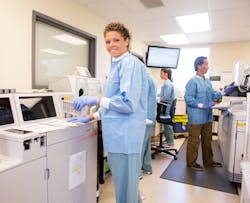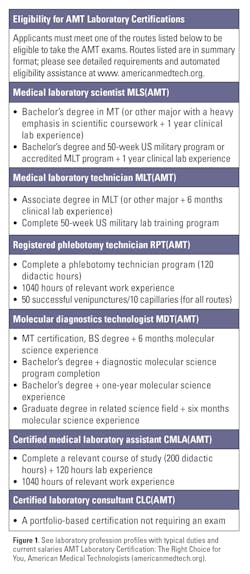No quick fix: A sustainable solution to lab personnel shortages
After years of discussion around the shortage of qualified clinical laboratory testing personnel, the combined causes are well documented such as changing demographics, fewer school programs, the pandemic, and lack of recognition of the profession. Meanwhile, solutions have emerged, and the American Medical Technologists (AMT) association is working on the front lines to resolve the problem. The crux of the issue is maintaining laboratory quality and producing reliable testing results while finding new ways to staff the laboratory.
AMT has a history of adapting with changes in the industry. AMT was started in 1939 by a group of working med techs who wanted to offer an additional quality program in the burgeoning field of clinical laboratory technology. Since then, the AMT mission has not changed but expanded to include certifications for more medical laboratory roles and other allied health professions. To ensure quality throughout the lab, AMT offers a set of certification exams that assess competency at every level from specimen collection and processing to molecular diagnostics (see Figure 1). AMT is accredited by the National Commission for Certifying Agencies (NCCA) of the Institute for Credentialing Excellence (ICE). According to James Fidler, PhD, director of testing and competency assurance for AMT, “The third-party recognition of a credential by NCCA is an important way of affixing an imprimatur, or ‘stamp of approval,’ attesting that the many elements comprising a certification program adhere to generally accepted industry standards. In addition, many states which have laws regulating the practice of particular occupations recognize AMT certification for licensure purposes, which is yet another reflection of the quality of a certification and its examinations.”
While staying true to its roots of maintaining quality in the lab as the goal, over time, AMT has adapted its eligibility criteria for certifications—and the exams themselves—to reflect the demands of the current industry. Years ago, laboratory personnel did not need an undergraduate degree to qualify for any credential from any agency. But practices evolve, and now a higher level of education is required for medical laboratory scientists. Still, several basic certifications for lab personnel are accessible with lower levels of thorough training to build competency.Sustainable versus non-sustainable solutions
Just as there is not a single cause for the shortage of qualified testing personnel, there will not be a single solution. Some answers to the shortfall may be more effective than others. For example, some AMT members are filling contract roles in the clinical lab and traveling to locations around the United States for lucrative pay and the opportunity to live in different parts of the country. But when they leave a full-time position, there is a new problem for the employer who lost them. Competing for talent through pay and perks may solve the problem in the near term, but it may not for the long term. Laboratories and systems are going to have to invest in longer-term solutions to acquire, develop, and retain talent.
Investing in staff can pay off and we are seeing that with the rise of employer-based training or apprenticeships. Borrowing from successful practices in other labor markets, many systems around the country are creating their own programs to hire, train, and get credentials for their employees so they have sufficient and properly trained staff to process the heavy workload of their labs.
There are bespoke solutions emerging in different pockets from rural hospitals to major systems. The solutions range from establishing registered apprenticeships through the US Department of Labor in order to obtain funding and create a stream of new employees, or simply hiring talent and training them systematically. AMT collaborates directly with employers in any of these scenarios from the outset to follow-through. When employers are initially planning for work-based training, AMT expertise can help them define the competencies necessary to fill a job role. The employer hires and trains the laboratorians. Then AMT helps at the end of the training process by assessing the trained individuals via a rigorous credentialing exam, which gains them a professional certification proving competency to fill an entry-level job.
For example, to fill a phlebotomist role, an employer can hire a dependable individual and give them hands-on training and enroll them in qualifying online courses to meet the required number of hours for phlebotomy certification. The right combination of didactic learning and verified experience makes those employees eligible to sit for the AMT certification exam. At the end, the individual has a job and a certification, and the lab has a reliable employee. You can work directly with AMT to make sure your training program is going to be sufficient to give individuals the best chance to succeed in obtaining a valuable credential.
If you need specimen processors, you can do as some hospitals have and train existing staff who are working in non-technical roles but want to improve themselves. To qualify as a Certified Medical Laboratory Assistant CMLA (AMT), they need to complete a course of study with 200 clock hours of didactic instruction and 120 hours of approved lab experience. Once they pass the test, they become members of the AMT professional association, which helps them maintain their professionalism and their skills.
We have seen a number of career-technical education startup programs around the country that certify students to work as lab assistants right out of high school. This can be the first rung of a career ladder that advances to medical laboratory technician (MLT) with an associate degree and medical laboratory scientist (MLS) or a molecular credential with a four-year degree.
Another AMT option can more quickly fill MLS roles. There is an untapped resource in science majors with degrees in biology or chemistry who would like to work in the lab but are considered unqualified. Labs can readily help them get qualified to work in the medical laboratory with a Medical Laboratory Scientist MLS (AMT) credential through our alternate route to certification. Labs have told us this is a well-kept secret, though that is certainly not our intention! Through the AMT alternative route, an individual with a qualifying science degree can take supplementary laboratory science courses, rotate through departments in the clinical lab, and become eligible to sit for the AMT Medical Laboratory Scientist certification in a year. It is a great way to attract and retain talent.
Developing and keeping current staff
High turnover consistently is cited as a significant expense for healthcare providers. To maintain those long-term employees, managers may consider offering further certification that develops talents and keeps employees on a career path. Molecular Diagnostics Technologist is a certification that appeals to working lab professionals and to those in the IVD industry.
Offering employees career progression opportunities can be a way to develop the skills and responsibility levels for your current staff or to attract new ones. Some AMT members stack credentials progressively by starting a career as a phlebotomist, progressing to MLT, and culminating through education as an MLS. There are a variety of routes one can take to become certified in the laboratory, and we have seen employers take advantage of these. While non-traditional solutions are not easy, they are successful. You’d be amazed how quickly some AMT partners are getting their programs up and running and building a pipeline to fill critical roles.
Certification proves skills to work at top of practice
Laboratory managers are well aware that a warm body is not enough to fill a job gap. Proven competency in a defined skill set is a necessity, which is the purpose of a certification. When managers know exactly what to expect of an individual with a certification, that certified person can be expected to work at the top of their credential in order to free up the time of more highly credentialed staff. We have seen laboratories utilize more Certified Medical Laboratory Assistants (CMLA) to help with work previously completed by an MLT. And an MLT may conduct tasks once the province of an MLS. A thorough, free resource of expected competencies by job role can be found at americanmedtech.org in the exam content outline for each lab certification role.
A brighter future through innovation
There is not going to be a quick fix to the shortage of qualified laboratory testing personnel. Many contributing factors are beyond the control of the laboratory. But innovation is a hallmark of laboratory work, and I am confident that laboratory leaders who are open to new ways of staffing will find the next generation to carry on their laboratories’ critical work and contributions to care.
About the Author

Kathy Cilia MLS(AMT), CAE
is executive director of American Medical Technologists (AMT), the credentialing agency and professional organization for more than 85,000 actively certified allied health professionals.

